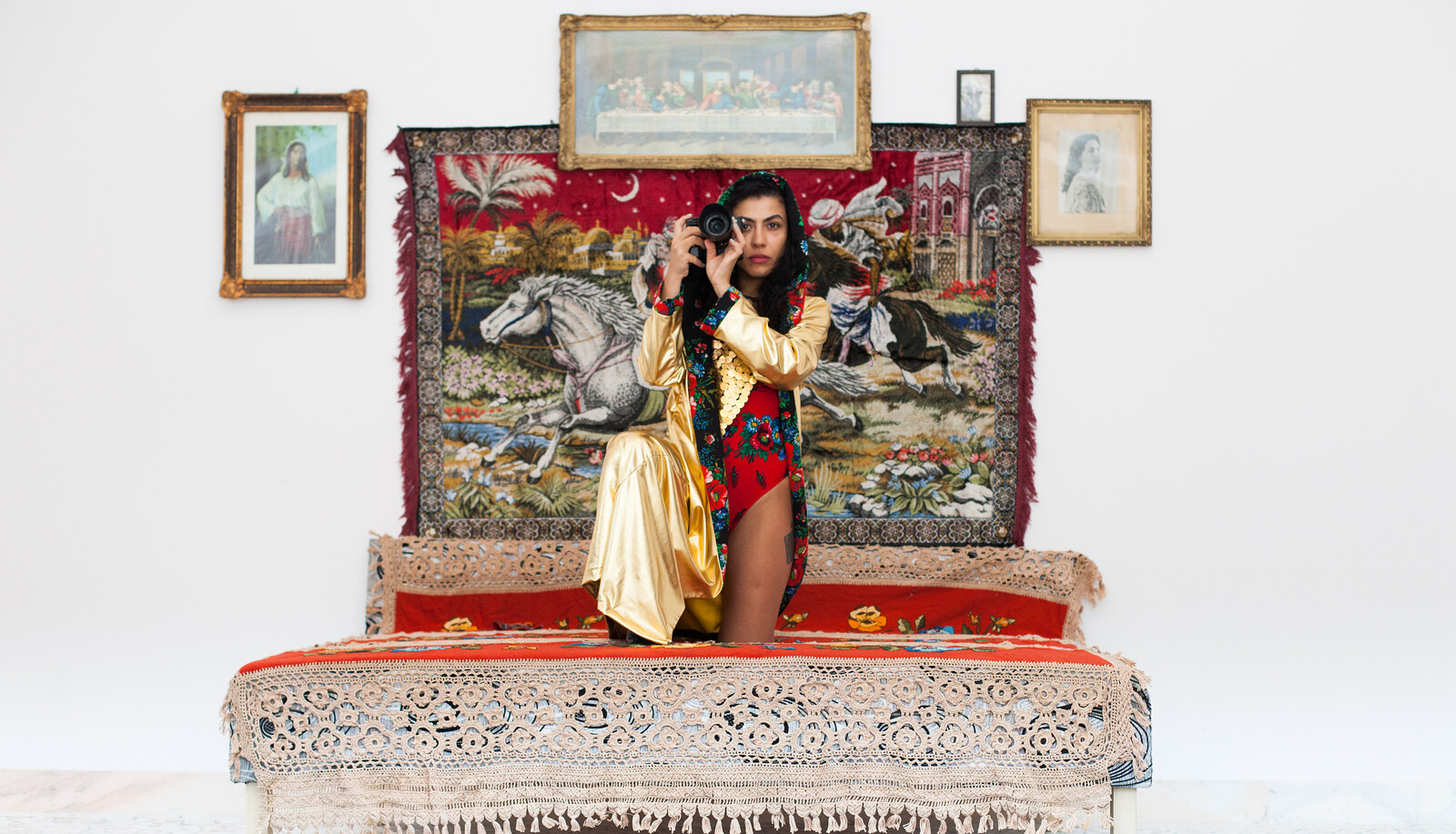Roma Women: Performative Strategies of Resistance
April 23–November 27, 2022
Collateral Events of the 59th International Venice Biennale.
Curated by Ilina Schileru.
Commissioned by Zeljko Jovanovic and Timea Junghaus on behalf of the European Roma Institute for Arts and Culture (ERIAC).
With special contributions from: Ethel Brooks, Ioanida Costache, Mihaela Drăgan, Carmen Gheorghe, Delia Grigore, Angéla Kóczé, Dijana Pavlovic, Erasma Vicenzina Pevarello, Alina Șerban
The magic-carpet post-Soviet Romani seraglio that Eugen Raportoru has created, the horses, the carpets, the marriage bed, are signifiers of our Romaniness, codes that we recognise amongst ourselves and that connect us across continents and contexts. This possibility lies, profoundly, in the Performative Strategies of Resistance that Roma Women bring to Venice, just as we bring them to the world in our everyday lives, in our everyday making of home and of camp, and in our everyday resistance against genocide, against patriarchy, against overlapping seraglios. These Strategies of Resistance are open to all, and they consist of the gifts we give to the world: Alina Șerban’s Storytelling takes up the legacy of Katarina Taikon, and the gift of the stories that we tell each other, ourselves, our children, as resistance and as intergenerational knowledge transmission, to share with all who wish to listen. Mihaela Drăgan and Giuvlipen Theatre give us the gift of Rituals, channelling the spirits, the witchcraft, that we Romnia embody, through our care, our knowledge, our expertise, our magic. (Ethel Brooks: Overlapping Seraglios, from the exhibition catalogue)
The European Roma Institute for Arts and Culture (ERIAC) is proud to present Eugen Raportoru: The Abduction from the Seraglio, accompanied by Roma Women: Performative Strategies of Resistance, Collateral Events at the 59th International Venice Biennale, curated by Ilina Schileru. In the long history of the Biennale, this is the fourth occasion when a presence of Roma art is ensured, and the second time when ERIAC is commissioner of the collateral event. This solo show of an artist of Roma origin, presented in collaboration with a group of Roma women artists and intellectuals reflecting upon, questioning and offering alternative perspectives on the main theme of “The Abduction,” represents a new milestone in European art history and an achievement of the vibrant European Roma cultural movement.
Among the most recognised painters of his generation in his country of origin, Eugen Raportoru (Bucharest, 1961) has always taken pride in his Roma origins. His recent experiments in installation narrate past memories from his childhood and often contain self-referential elements through which he creates a hidden genealogy of the unspoken truths of domestic environments. The exhibition comprises a series of site-specific installations composed of numerous household objects inherent to the (Roma) domestic space, while a selection of paintings retraces the fraught trajectory of oriental carpets in Eastern European households. The series is grounded in an understanding of the significance of—and bearing witness to—the narratives that such objects embody, as well as their capacity to inform and reflect Roma culture, Roma lives and the distribution of Roma knowledge.
Abduction in this context is charged fundamentally with patriarchal projections onto the female (and the Other) body. Roma Women: Performative Strategies of Resistance, a series of interventions, actions and performances, reflects on the double minority position that Roma women occupy. The audience is invited to enter a resonatory chamber, and to listen and learn from their voices and stories.
The artists invite the viewer to meditate on the specific time-space configuration of notions of identity and history, as well as trauma, hope, the body and affect. Focusing a magnifying glass on the ongoing mystification, exoticism, feminisation, sexualisation and criminalisation of the Roma body in western society, The Abduction invites a critical interrogation of the links between power and realism, violence and the picturesque.
Commissioner: The European Roma Institute for Arts and Culture (ERIAC) has a unique and single mandate as the first transnational, European-level organisation for the recognition of Roma arts and culture. The European Roma Institute for Arts and Culture (ERIAC) is a joint initiative of the Council of Europe, the Open Society Foundations, and the Roma Leaders’ initiative—the Alliance for the European Roma Institute. ERIAC exists to increase the self-esteem of Roma and to decrease negative prejudice of the majority population towards the Roma by means of arts, culture, history, and media. The Commissioners of the Roma exhibition of the 59th Venice Biennale are Zeljko Jovanovic, Chair of the Board, and Timea Junghaus, Executive Director of ERIAC.
Supported by: the Council of Europe, the Alliance for the European Roma Institute for Arts and Culture, Open Society Foundations, Federal Foreign Office Germany, ERSTE Foundation, Ufficio Nazionale Antidiscriminazioni Razziali (UNAR), Stiftung KAI DIKHAS, Istituto Romeno di Cultura e Ricerca Umanistica de Venezia, the National Centre for Roma Culture - Romano Kher, Agenția Împreună, Otilia Flonta, Wintask Software, Heidelberg Cement, Viața în Mov.
Address: Istituto Veneto di Scienze, Lettere ed Arti, Campo S. Stefano, 2945 S.Marco, 2946, 30124 Venice
The exhibition is open: April 23–November 27, 2022, Tuesday–Sunday, 9:30am–5:30pm. More information: eriac [at] eriac.org / T +49 30 40 633 733
Press viewing of the exhibition: 22 April 2022 at 5 pm with the artists, curator, and commissioner. Register at: press [at] eriac.org
Join the Opening Celebration at Palazzo Loredan on April 22, 2022, 6–7pm.


